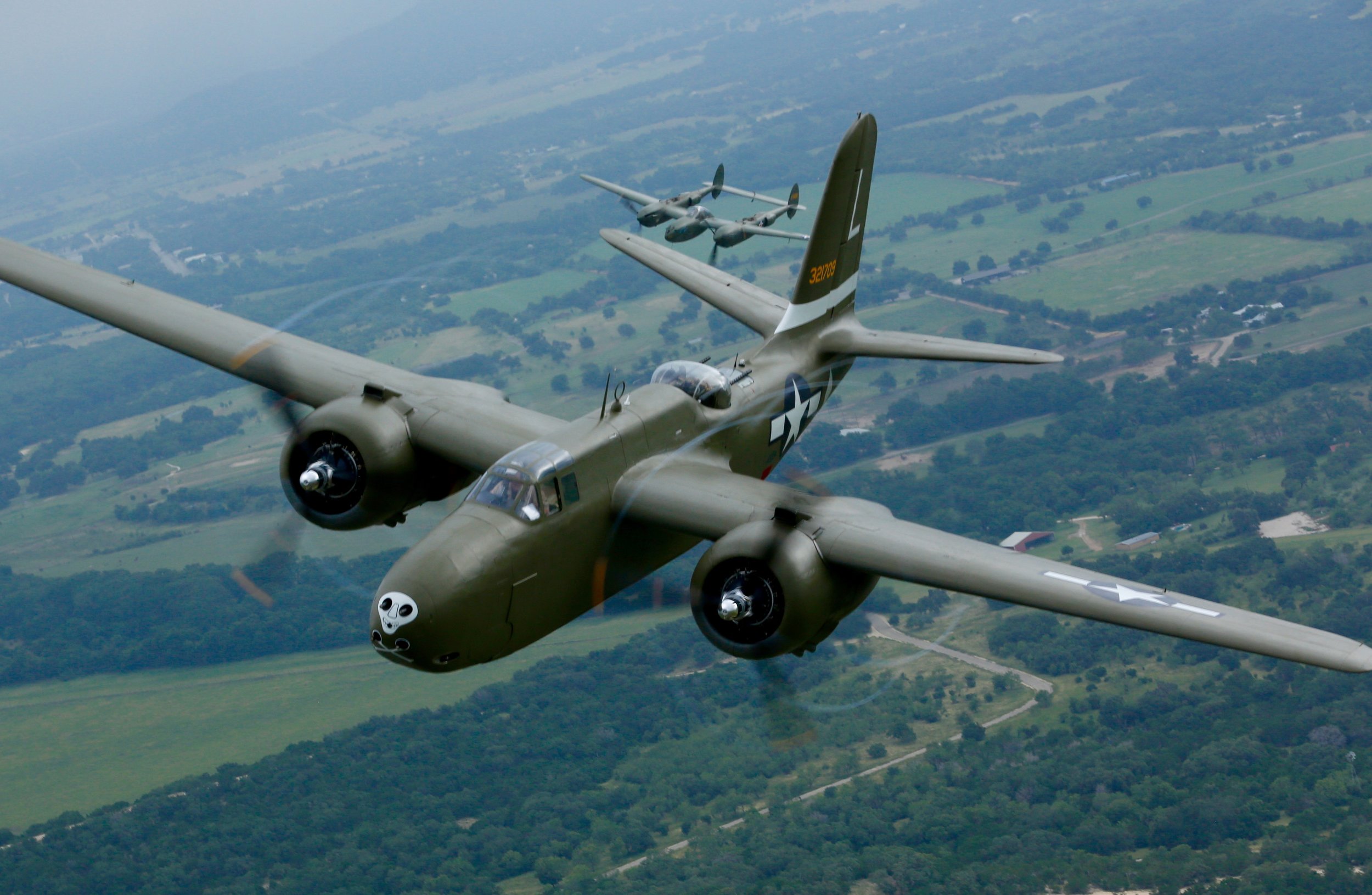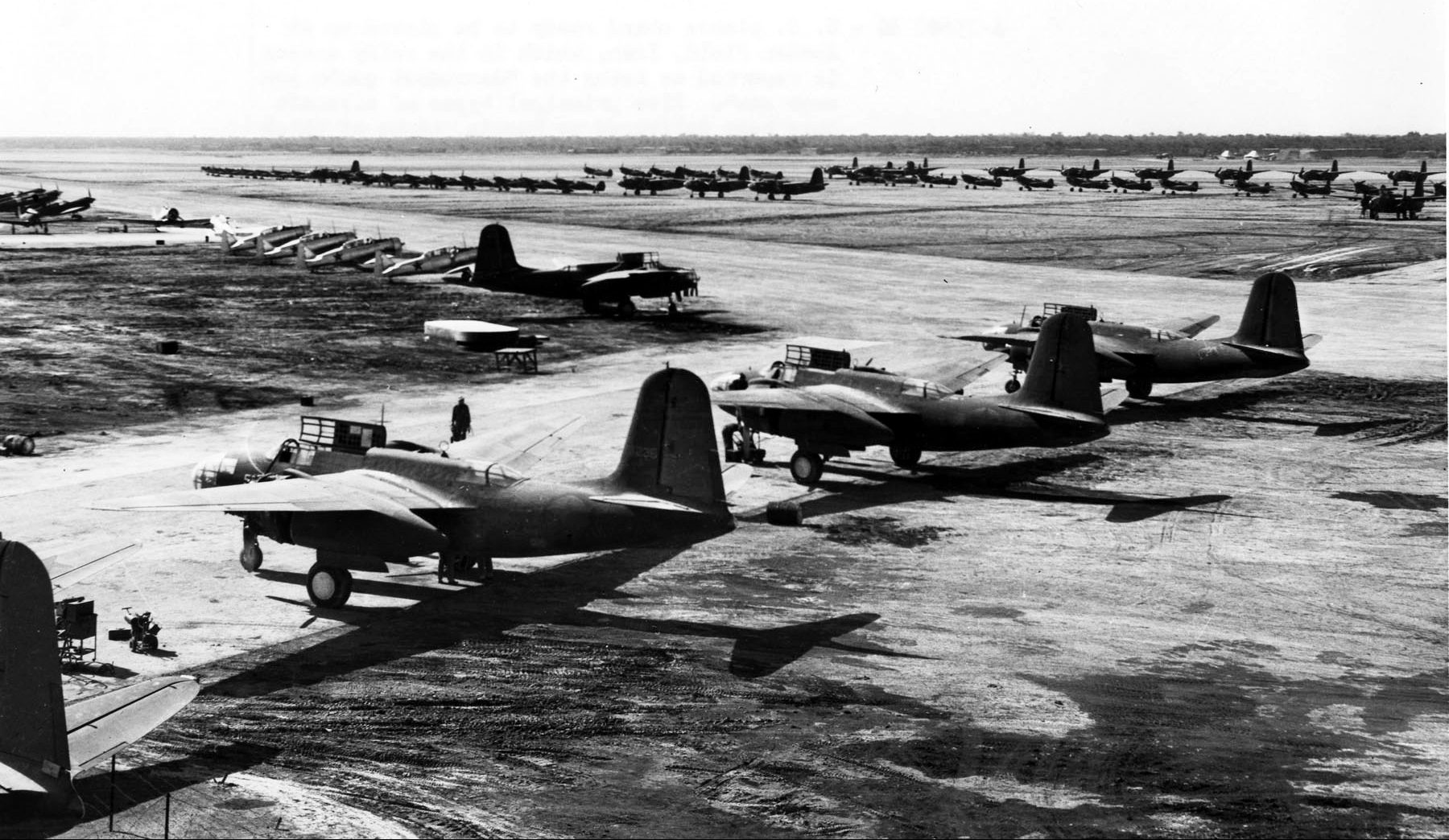A-20 Aircraft Ww2 - Almost one year after the French had taken delivery of their DB-7s, A-20A Havocs were delivered to the USAAC/USAAF and were operated by the 3rd Bombardment Group at Savannah Georgia. Additional aircraft were provided for the 27th Bombardment Group.
Initially, the engines suffered from overheating and after modifications were made to improve engine cooling, pilots were reporting good results. They performed training exercises in Shreveport, Louisiana in September 1941 and shortly afterwards, the aircraft was officially designated the Havoc.
A-20 Aircraft Ww2

At the end of the war, most Havocs were scrapped and by the early 1960s, only six complete airframes were known to be in existence. Recently, more Havocs have been discovered at crash sites in Russia and the jungles of New Guinea and are undergoing restoration.
Production ended on September 20, 1944 with a total of 7,098 Havocs built by Douglas and an additional 380 built by Boeing. By the time of V-E Day, all USAAF A-20 Havocs were replaced with A-26 Invaders and the British Bostons were replaced with de Havilland Mosquitoes.
The Boston III (DB-7B) was the first batch to be ordered directly for the RAF. It was a pleasant surprise to the British crews who had been operating Bristol Blenheims.8 It was twice as powerful and carried twice the load and was a very strong reliable aircraft—it was also 80 mph faster.
If an engine was lost on takeoff, control was considered outstanding with one-engine performance, unlike the Lockheed P-38 Lightning and Martin B-26 Marauder which took a lot of experience to maintain control on one engine. As a light-bomber, it was operated by the No.

88 Squadron in conjunction with Bristol Blenheim IVs. The Nos. 88 and 226 Squadrons were involved in the attempt to stop the "Channel Dash" by the German battlecruisers Scharnhorst and Gneisenau. The German ships made the passage safely because they were able to jam British radar delaying offensive movement by British aircraft.10
The 7A would have been obsolete upon delivery and it was revised. The new design would have a three man crew and power was increased with two 1,100 hp Pratt & Whitney R-1830C Twin Wasp engines.
The observers compartment was eliminated and the bomb bay enlarged. The fuselage was narrowed and allowed no physical contact between the crew members. The aircraft was unique in that it could be built with two different nose configurations as an attack or bomber version.
The attack version had a solid nose designed to carry six 0.30 caliber machine guns with two 0.50 caliber machine guns in the nose. The bomber version nose was glazed and allowed space for a bombardier and bomb site which replaced the machine guns.
The new design was given the Douglas designation Model 7B.4 (adsbygoogle = window.adsbygoogle || []).push({}); All DB-7 versions were known to the British as the Boston. The British later converted their Bostons to radar equipped night-fighters and these were collectively known as Havoc Is.

The USAAF referred to the plane as the A-20 Havoc, and the reconnaissance version as the F-3. Design work began in 1936 by Donald Douglas, Jack Northrop and Ed Heinemann as the Model 7A attack-bomber with a crew of two, a top speed of 250 mph, and a gross weight of 9,500 lbs.
It was powered by two 450 hp Pratt & Whitney R-985 Wasp Junior engines, but conditions were changing rapidly in 1937, due to events in the Chinese and Spanish wars. Looking to replace their Curtiss A-12s and Northrop A-17s, the US Army Air Corps (USAAC) issued the following requirements:3
In the Western Desert and the Mediterranean, Bostons were flown by RAF Squadrons Nos. 13, 18, 55 and 114 and the Nos. 12 and 24 Squadrons of the South African Air Force (SAAF). They engaged in raids dubbed ``Boston Tea Parties'' and flew missions in Tunisia, Sicily and Italy.
Bostons were replaced with de Havilland Mosquitoes in 1946. After the United States entered the war, plans were made to produce an aircraft specifically as a night-fighter. The Northrop P-61 would eventually fulfill this role, but until then, something else was needed to fill the gap.
The Americans followed the British lead and designated the night-fighter version of the Havoc as the P-70, making it perhaps the only bomber to convert to a fighter. 6 The P-70 was equipped with the British AI Mk.IV radar and
four 20 mm canons mounted in a bathtub located in the bomb bay. Training was conducted in Orlando, Florida and crews used to perform mock low-altitude attacks on nearby Panama City and drop dummy bombs on trains.
The next morning, train crews would be puzzled to find fluorescent dye splattered on top of the cars. 7 The A-20B was powered the same as the A model and had a modified Plexiglas nose. Bombs racks were changed from a vertical to horizontal configuration and the bomb bay could house a 200 gallon (750 liters) fuel tank for ferrying purposes.
Two 0.50 caliber machine guns were mounted in the forward fuselage, one 0.50 was placed in the open dorsal position and one 0.30 was mounted in the ventral position. A field modification replaced the plastic nose with a solid nose, which housed four to six 0.50 caliber machine guns.
999 A-20Bs were built at the Douglas plant in Long Beach, California. Six A-20Bs were transferred to the US Navy and designated BD-2s. Visibility for the Havoc was good from the cockpit and stall characteristics were considered docile and it handled very well during low flying operations.
During evaluations, it was found that the Spitfire V could only keep up with it for only a few minutes before overheating, but the Bristol Beaufighter was said to be slightly faster. More than 3,600 havoc were sent to Russia under lend-lease, which was almost twice that sent to the British, and substantially more than the 1,962 aircraft delivered to the USAAF.

The majority of the aircraft delivered to the Soviets were A-20s, but records indicate that 20 aircraft were DB-7Bs. The first planes to go into service with the RAF were Havoc Is with the No. 23 Squadron during the winter of 1940-41 in night fighter roles.
They were later joined with the No. 418 Squadron (RCAF) and the No. 605 Squadron with Boston IIIs. Other squadrons included the No. 25, No. 85 and no. 93. Turbinlite versions of the Havoc I, Havoc II and Boston III were operated by the Nos.
530 to 539 Squadrons. It was also known as the DB-7 (Douglas Bomber 7) and as the Boston or Ranger to the British. It was said to be easy to fly with good handling characteristics during takeoff and landing.
It represented an advance in flight control systems with light handling during high-speed flight, with no overbalance on small control inputs. The tricycle landing gear made takeoff, landing and ground handling very simple and pilots were able to fly it with a minimum of instructions.
It also provided a stable gun platform for night-fighter missions. Handling with one engine out was also said to be very satisfactory, although the prototype crashed while simulating an engine-out procedure. 2 It was very durable and was able to withstand extreme battle damage and found a role in every combat theater of the war.

It was a "pilot's airplane". The final foreign recipient of the Havoc was the Fora Area Brasileira, which received 30 SAAF A20G to A-20K Havocs in 1944-45. They saw very little service and one A-20K is on display at the Museu Aerospespacial in Brazil.
The first Havocs to perform bombing missions in the Pacific were operated by the 3rd and 89th Bombardment Group and began operations on August 3, 1942 from Port Moresby, New Guinea. They were later joined by the 312th and 417th Bombardment Groups and by September 1944, the Fifth Air Force had a peak inventory of 370 Havocs.
By the war's end, all three groups were operating with A-20Gs. The majority of aircraft were used in low-level missions and some aircraft were equipped with three-cluster bazooka tubes under each wing. The A-20A was the first major production version for the USAAC.
They were powered by 1,600 hp Wright R-2600-11 engines and were not turbocharged. Turbochargers were not included because of cooling difficulties and since the Havoc was intended to perform low and medium altitude missions, turbocharging was not required.
Weight was increased to 3,750 lbs (1,700 kg), self-sealing fuel tanks were installed and fuel capacity was 394 US gallons (1,500 liters). The planned armament consisted of four 0.30 caliber machine guns in side-mounted fuselage blisters instead of in the nose, twin 30s in an open dorsal position, and one 0.30 in the ventral position.
Provisions were made to mount aft-firing 30s in the engine nacelles triggered by a foot pedal by the pilot, but these were rarely installed.9 Not being perfect, there were some complaints. The takeoff speed was 100 mph, so the airplane required a lot of runway, and the flaps operated too slowly and were not very effective making it difficult to land on grass airfields, leading to accidents caused by skidding.
Dual controls were located in the aft gunner's compartment, but were said to be of little use. The dual controls were eliminated on the A-20G. The no. 22 Squadron of the Royal Australian Air Force operated 69 DB-7s and A-20s against Japan.
They had a variety of different versions of the Havoc from the SAAF and the Netherlands, but to the Australians, they were all known as Bostons. Operations began from Ward's Strip in Port Moresby on November 5, 1942. The squadron was reequipped with Bristol Beaufighters after suffering their worst loss of 13 Bostons on the ground after a Japanese raid at Morotai on November 23, 1944.
a20 attack aircraft, douglas a 20 bomber, a20 airplane, douglas a 20, a 20 bomber, wwii a 20 bomber, boston bomber aircraft ww2, world war 2 bombers